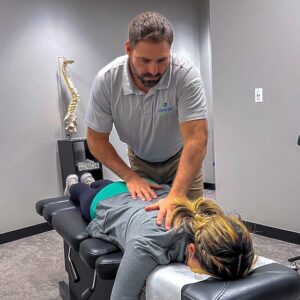Are you tired of dealing with the persistent discomfort of sciatica pain? This nerve-related issue can significantly impact your daily life, from hindering your mobility to affecting your overall well-being. Seeking relief is crucial, and one avenue worth exploring is chiropractic care.
Chiropractors are healthcare professionals who specialize in diagnosing and treating musculoskeletal problems, including sciatica. At Evolve Chiropractic of Gilberts, our chiropractic services are tailored to address sciatic nerve pain effectively and help patients reclaim their lives.
Understanding Sciatica
Before delving into how chiropractor alleviate sciatic nerve pain, it’s essential to comprehend what sciatica entails. Sciatica refers to pain that radiates along the path of the sciatic nerve, which runs from your lower back, through your hips and buttocks, and down each leg. This discomfort often manifests as a sharp, shooting pain, tingling, numbness, or weakness in the affected leg.
Chiropractic Approach to Sciatica
1. Detailed Examination and Diagnosis:
Chiropractors undertake a comprehensive evaluation process to accurately diagnose the root cause of sciatica. This involves an in-depth analysis of the patient’s medical history, including prior injuries or conditions, followed by a series of physical tests. Additionally, advanced imaging studies such as X-rays, MRIs, or CT scans may be utilized to visualize spinal structures and identify any abnormalities, herniated discs, bone spurs, or nerve impingements that contribute to sciatic nerve irritation.
2. Spinal Adjustments:
Chiropractic adjustments or spinal manipulations form the cornerstone of sciatica treatment. These adjustments involve precise and gentle techniques that target specific areas of spinal misalignment or subluxations. By realigning the spine, chiropractors aim to relieve pressure on the sciatic nerve, promoting proper nerve function and reducing pain. Each adjustment is tailored to the patient’s condition, ensuring a personalized and effective approach to spinal realignment.
3. Soft Tissue Therapy:
In addition to spinal adjustments, Chiropractor Near Me often incorporate soft tissue therapies to complement treatment. Techniques such as massage therapy, myofascial release, or trigger point therapy help alleviate muscular tension, reduce inflammation, and improve blood circulation around the affected area. Addressing soft tissue dysfunction assists in reducing pressure on the sciatic nerve, easing discomfort, and enhancing the body’s natural healing process.
4. Rehabilitation and Exercises:
Chiropractors design specific rehabilitation programs comprising targeted exercises and stretches to strengthen muscles, particularly those supporting the spine and lower back. These exercises aim to improve flexibility, enhance core stability, and correct imbalances, thereby reducing stress on the sciatic nerve. Patients are guided through these routines, empowering them to actively participate in their recovery and prevent future sciatica occurrences.
5. Postural Recommendations and Ergonomics:
Chiropractors provide valuable insights into proper posture and ergonomic adjustments tailored to the patient’s lifestyle. This guidance extends to ergonomic modifications in workstations, recommendations for ergonomic furniture, and strategies for maintaining correct posture during daily activities. Correcting posture and implementing ergonomic changes can significantly reduce spinal stress, easing pressure on the sciatic nerve and supporting long-term pain management.
6. Lifestyle Modifications:
Beyond the treatment sessions, chiropractors emphasize lifestyle modifications that promote overall spinal health and reduce sciatica-related discomfort. This includes dietary recommendations to reduce inflammation, stress management techniques, and guidance on maintaining proper sleep habits. These lifestyle adjustments work synergistically with chiropractic interventions to optimize healing and enhance the body’s ability to manage sciatica pain effectively.
7. Nerve Flossing Techniques:
Chiropractors often incorporate nerve flossing exercises as part of a comprehensive sciatica treatment plan. These specialized movements involve gently gliding and releasing tension along the path of the affected sciatic nerve. By carefully mobilizing the nerve and surrounding tissues, nerve flossing techniques aim to alleviate nerve compression, decrease irritation, and improve overall nerve mobility, providing relief from sciatic pain and discomfort.
8. Instrument-Assisted Adjustments:
In chiropractic care, some practitioners use specialized instruments like the Activator or ArthroStim for adjustments. These tools deliver controlled, low-force impulses to specific areas of the spine, offering an alternative approach for patients who may prefer or require gentler manipulations. Instrument-assisted adjustments are precise, focusing on realigning the spine and reducing nerve pressure without the characteristic popping or cracking associated with manual adjustments.
9. Traction Therapy:
Chiropractic traction is a therapeutic technique aimed at decompressing the spine and reducing pressure on the affected discs and nerves. Through mechanical devices or manual methods, chiropractors gently stretch the spine, creating space between vertebrae and alleviating nerve compression. Traction therapy can effectively relieve sciatic pain by improving spinal alignment and enhancing the body’s natural healing process.
10. Cold Laser Therapy:
Cold laser therapy, also known as low-level laser therapy (LLLT), is a non-invasive treatment method employed by chiropractors to target sciatic nerve pain. This therapy utilizes specific wavelengths of light to penetrate deep into tissues, stimulating cellular activity, reducing inflammation, and accelerating the healing process. Cold laser therapy promotes tissue repair, reduces pain sensitivity, and enhances circulation in the affected area, aiding in the relief of sciatica symptoms.
11. Electrical Stimulation:
Electrical muscle stimulation (EMS) and transcutaneous electrical nerve stimulation (TENS) are electrotherapy modalities used in chiropractic care for sciatica. EMS involves delivering mild electrical currents to stimulate muscle contractions, promoting relaxation and enhancing blood flow. TENS units, on the other hand, work by sending electrical impulses through the skin to disrupt pain signals, providing pain relief and improving nerve function in the affected area.
12. Core Strengthening Exercises:
Chiropractors emphasize the importance of core strengthening exercises in managing sciatica. These exercises target muscles surrounding the abdomen, lower back, and pelvis to provide stability and support to the spine. By strengthening the core muscles, chiropractic care aims to improve spinal alignment, reduce pressure on the sciatic nerve, and prevent future episodes of sciatica.
13. Trigger Point Therapy:
Trigger point therapy is a hands-on technique used by chiropractors to identify and treat localized areas of muscular tension or knots contributing to sciatic nerve irritation. Chiropractors apply manual pressure or use specialized tools to release these trigger points, alleviating muscle tension, improving flexibility, and reducing sciatica-related discomfort.
14. Flexion-Distraction Technique:
The flexion-distraction technique is a gentle chiropractic method involving a specialized treatment table. This technique utilizes a pumping action on the spine, applying gentle traction and flexion to the affected spinal segments. The goal is to increase intervertebral disc space, reduce pressure on the nerves, improve circulation, and promote the healing of damaged discs associated with sciatica.
15. Home Care Strategies:
Chiropractors educate patients on practical self-care strategies to manage sciatica symptoms at home. These strategies often include guidance on maintaining proper posture, recommended stretching exercises to alleviate muscle tension, instructions on applying heat or ice therapy, ergonomic adjustments, and lifestyle modifications. Implementing these home care strategies supports the treatment received during chiropractic sessions, aiding in pain relief and optimizing the healing process.
Benefits of Chiropractic Care for Sciatica
Non-Invasive Approach: Chiropractic care stands out for its non-invasive nature. This approach avoids the need for surgical interventions, offering a more conservative and natural alternative. By utilizing techniques such as spinal adjustments, chiropractors aim to realign the spine, alleviate nerve pressure, and reduce inflammation. This not only mitigates sciatic nerve pain but also promotes the body’s innate healing mechanisms, fostering recovery without invasive procedures or their associated risks.
Drug-Free Pain Management: Chiropractic care adopts a drug-free approach to managing sciatica pain. Unlike medications that may carry potential side effects or risks of dependency, chiropractic treatments focus on addressing the root cause of the pain. Through spinal adjustments, therapeutic exercises, and lifestyle recommendations, chiropractors aim to restore spinal health and functionality, reducing the reliance on pharmaceuticals for pain relief.
Personalized and Holistic Care: Recognizing the uniqueness of each patient’s experience with sciatica, chiropractors emphasize personalized care. Initial assessments involve comprehensive examinations to identify specific spinal misalignments or issues contributing to sciatic nerve compression. Based on this evaluation, tailored treatment plans are developed, integrating various chiropractic techniques to suit individual needs. This personalized approach not only targets the symptoms but also addresses the underlying causes, ensuring a more holistic and effective healing process.
Enhanced Mobility and Functionality: Sciatica pain often restricts mobility and limits daily activities. Chiropractic care aims to restore proper spinal alignment and function, alleviating nerve compression and reducing associated discomfort. By alleviating pressure on the sciatic nerve, patients often experience improved flexibility, reduced stiffness, and increased range of motion. This enhancement in mobility enables individuals to engage more comfortably in their daily routines, contributing to an overall improvement in their quality of life.
Long-Term Relief and Preventive Care: While immediate pain relief is a primary goal, chiropractic care emphasizes long-term solutions. Beyond addressing current symptoms, chiropractors focus on correcting spinal misalignments and prescribing rehabilitative exercises to prevent future episodes of sciatica. These preventive measures aim to maintain spinal health, reduce the likelihood of recurring sciatic nerve pain, and foster sustained relief, enabling patients to proactively manage their condition.
Complementary to Other Treatments: Chiropractic care can complement other forms of healthcare interventions. Integrating chiropractic treatments with physical therapy, pain management strategies, or other healthcare modalities can synergistically enhance outcomes. Collaborative efforts among healthcare professionals ensure a comprehensive approach, addressing various aspects of sciatica pain, and offering patients a more comprehensive treatment regimen.
Improved Quality of Life: Chronic sciatica pain can significantly impact an individual’s overall well-being. Beyond physical discomfort, it can affect sleep, work productivity, and emotional health. Chiropractic care’s comprehensive approach not only targets pain relief but also focuses on restoring functionality and improving overall quality of life. Patients often report an improvement in their ability to perform daily activities, better sleep patterns, reduced stress, and an overall sense of well-being after receiving chiropractic care for sciatica.
Patient Education and Empowerment: Chiropractors prioritize patient education as a fundamental aspect of their care. They take the time to thoroughly explain the underlying causes of sciatica, the importance of spinal health, and how specific treatments work. By imparting this knowledge, patients gain a deeper understanding of their condition, enabling them to actively participate in their recovery. Empowered with information about proper posture, ergonomics, and lifestyle modifications, individuals can make informed choices to support their healing journey, fostering a sense of control over their health.
Tailored Rehabilitation Programs: Chiropractors create tailored rehabilitation programs aimed at aiding recovery from sciatica. These programs encompass a range of therapeutic exercises and stretches meticulously designed to target affected muscles, improve flexibility, and enhance spinal stability. By incorporating these personalized exercises into daily routines, patients actively contribute to their healing process, accelerating recovery and promoting lasting relief from sciatic nerve pain.
Focus on Functional Improvement: Chiropractic care extends beyond pain reduction to prioritize functional improvement. Chiropractor Gilberts aim to restore optimal function to the affected areas, emphasizing the enhancement of nerve conductivity, muscle strength, and normal movement patterns. Through targeted treatments and exercises, patients regain their full range of motion and functional abilities, allowing them to resume their daily activities without limitations imposed by sciatic nerve discomfort.
Holistic Wellness Approach: Chiropractic care takes a holistic approach, recognizing the interconnectedness of spinal health with overall well-being. Beyond treating the symptoms of sciatica, chiropractors focus on optimizing spinal alignment and nerve function to support the body’s ability to self-heal. By enhancing overall health and vitality, chiropractic care contributes to a sense of holistic well-being that transcends the alleviation of pain.
Pain Management Without Dependency: Chiropractic care offers an alternative pain management strategy that doesn’t rely on pharmaceuticals. For individuals concerned about potential dependencies or adverse effects of pain medications, chiropractic treatments provide a drug-free path to pain relief. By addressing the root cause of the pain, chiropractic care helps individuals experience relief without the reliance on medication, emphasizing natural healing mechanisms.
Evidence-Based Care: Chiropractors base their treatments on evidence-based practices supported by scientific research. The effectiveness of chiropractic care for relieving sciatica pain is substantiated by numerous studies, lending credibility to its role as an effective treatment option. This evidence-based approach assures patients that the care they receive is grounded in scientific validity.
Customized Treatment Progression: Chiropractors adapt treatment plans as patients progress through their recovery journey. Regular reassessment allows for modifications in treatment approaches, ensuring that the care provided evolves to meet the changing needs of the patient’s healing process. This dynamic approach ensures that treatment remains effective and aligned with the patient’s progress.
Posture Correction and Ergonomic Guidance: Chiropractors offer comprehensive guidance on posture correction techniques and ergonomic improvements tailored to each individual. By addressing poor posture habits and recommending ergonomic adjustments at workstations or in daily activities, chiropractors aim to prevent further aggravation of sciatica and promote spinal health in everyday life. These recommendations empower patients to make necessary changes to their daily routines, aiding in the prevention of future spinal issues.
Don’t let sciatica hold you back from enjoying life to the fullest. Schedule a consultation with our experienced chiropractors today and take the first step towards a pain-free tomorrow.
Why Choose Us?
Welcome to Evolve Chiropractic of Gilberts, where your wellness journey is our top priority. As the premier chiropractic destination in Gilberts, we take pride in delivering exceptional care focused on your individual needs. Our dedicated team of chiropractors utilizes advanced techniques and a holistic approach to address pain, restore function, and optimize your health. At Evolve, we believe in empowering our patients to live their best lives by providing expert chiropractic services tailored to enhance your overall well-being. Join us on the path to a healthier you at Evolve Chiropractic of Gilberts.
219 E Higgins Rd, Gilberts, IL 60136, United States
847-649-3422
https://myevolvechiropractor.com/locations/chiropractor-in-gilberts-illinois





